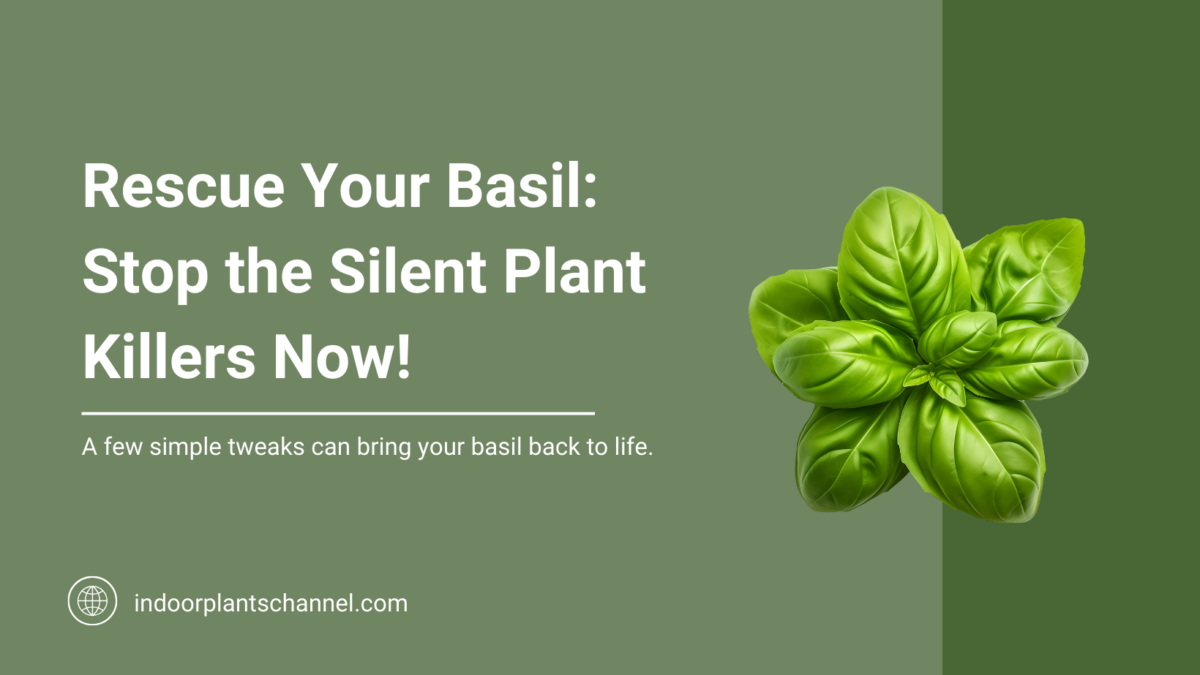Basil, the beloved herb that graces everything from pesto to cocktails, is often seen as a low-maintenance plant—a staple for even the most novice indoor gardeners. But here’s the twist: despite its reputation, Indoor Basil Growing Problems can quickly turn thriving green leaves into a struggling mess.
Black spots and leaf discoloration are among the most common issues, often signaling deeper problems. These seemingly minor blemishes can be warning signs of fungal infections, bacterial diseases, or environmental stress—threatening not just the plant’s health but also its culinary value.
Why does this matter now? As more people turn to indoor gardening for fresh, homegrown herbs, the challenges of maintaining healthy basil plants in controlled environments are becoming increasingly apparent. The stakes are high: a thriving basil plant isn’t just a kitchen convenience; it’s a small but vital step toward sustainable living.
What if the black spots on your basil aren’t just a problem to fix but a clue to understanding the delicate balance of indoor ecosystems? Let’s explore.
The Importance of Healthy Basil Plants
Healthy basil plants are more than just a culinary asset—they’re a living indicator of your indoor environment’s balance. For instance, black spots on basil leaves often stem from fungal infections, which thrive in conditions of poor air circulation and excessive humidity. Addressing these issues doesn’t just save your basil; it enhances the overall health of your indoor ecosystem by reducing the risk of mold and other plant diseases spreading to nearby greenery.
Stress factors like nutrient deficiencies or inconsistent watering can alter the concentration of essential oils, diminishing the herb’s signature aroma and taste. By maintaining optimal conditions—such as consistent soil moisture and proper fertilization—you’re not just growing a plant; you’re cultivating a superior culinary ingredient.
This focus on basil health also ties into broader themes of sustainable living. A thriving basil plant reduces reliance on store-bought herbs, cutting down on packaging waste and transportation emissions. It’s a small but meaningful step toward a greener lifestyle, proving that even the smallest plants can have a big impact.
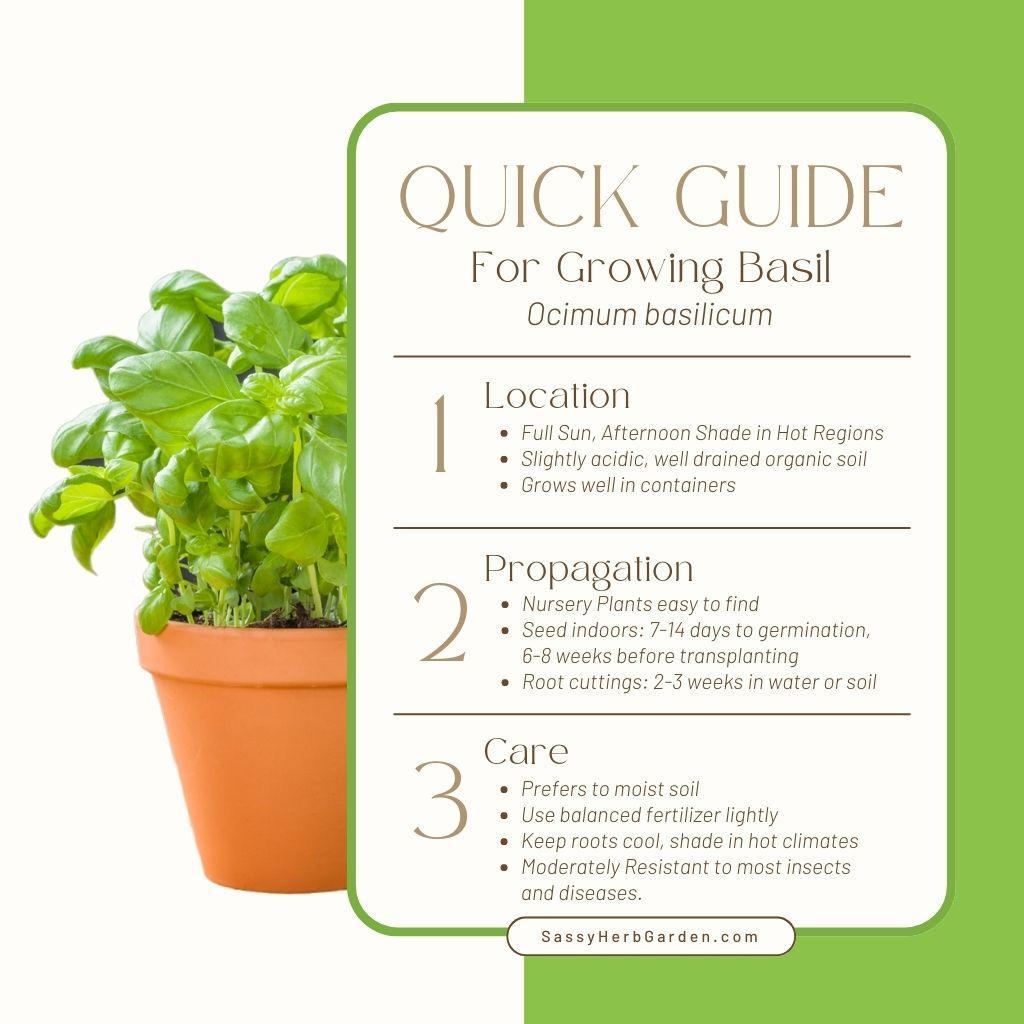
Common Challenges in Indoor Basil Cultivation
Basil requires 6–8 hours of bright, direct light daily, but indoor environments often fail to provide this naturally. While grow lights are a popular solution, many gardeners underestimate the importance of light spectrum. Full-spectrum LED lights mimic natural sunlight, promoting balanced growth and preventing leggy, weak stems—a common issue with insufficient or poorly distributed light.
High humidity levels, while beneficial for some plants, can encourage fungal diseases like downy mildew in basil. Using a small fan to improve air circulation can mitigate this risk, creating a healthier environment for the plant.
These insights highlight the need for tailored approaches in indoor gardening. By combining precise lighting strategies with microclimate management, gardeners can overcome these challenges and unlock basil’s full potential, both in growth and flavor.
Understanding Basil Plant Physiology
Basil’s physiology is a masterclass in adaptability, but it thrives only when its core needs are met. At its heart, basil relies on a delicate balance of photosynthesis and nutrient uptake. For instance, studies show that basil grown under red and blue LED light not only achieves higher biomass but also enhances essential oil production, directly impacting its flavor profile.
When exposed to suboptimal conditions—like low light or nutrient deficiencies—it reallocates resources, often sacrificing leaf quality to sustain survival. This explains why stressed basil plants develop pale, less aromatic leaves, a common frustration for indoor gardeners.
In hydroponic setups, maintaining an electrical conductivity (EC) of 1.0–1.6 ensures optimal nutrient absorption. Think of it as fine-tuning an engine; too much or too little disrupts the plant’s growth rhythm, leading to stunted development or nutrient burn.
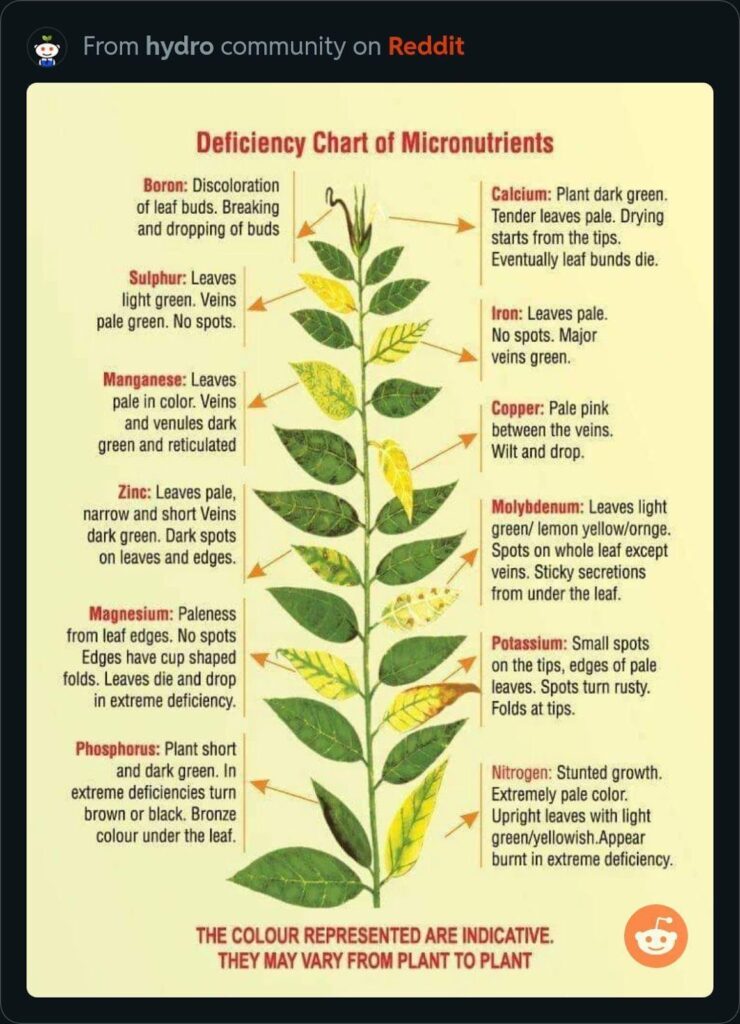
Essential Growth Requirements
Light quality is the unsung hero of basil cultivation. While most growers focus on duration, the spectrum of light plays a pivotal role in plant health. Red wavelengths (around 660 nm) drive photosynthesis, while blue light (450 nm) enhances chlorophyll production and leaf structure. A study on hydroponic basil revealed that combining these wavelengths increased both biomass and essential oil concentration—key for culinary applications.
Basil thrives at 60–70% relative humidity, but levels above this can invite fungal diseases like downy mildew. Using a hygrometer and a small fan to maintain airflow can prevent these issues, creating a microclimate that mimics outdoor conditions.
Invest in full-spectrum LED lights and monitor humidity daily. Think of it as creating a “climate recipe” tailored to basil’s needs—precision here translates directly to healthier, more aromatic plants.
Leaf Anatomy and Function in Basil
Stomatal density regulate gas exchange, balancing CO₂ intake for photosynthesis with water vapor loss. Research shows that basil grown under moderate blue light (450 nm) develops higher stomatal density, enhancing photosynthetic efficiency and resilience to fluctuating humidity.
A well-developed cuticle, influenced by consistent light exposure and nutrient availability, can reduce susceptibility to fungal infections like black spots. For growers, this means ensuring a steady supply of calcium and silicon, which fortify the cuticle structure.
Monitor light spectrum and nutrient levels to influence stomatal behavior and cuticle health. By understanding these anatomical features, you can fine-tune your growing environment, leading to basil plants that are not only healthier but also more productive and flavorful.
Identifying Black Spots and Leaf Issues
Black spots on basil leaves are more than cosmetic—they’re diagnostic clues. For instance, fungal infections like Cercospora leaf spot thrive in damp conditions, leaving dark spots with brown halos. Contrast this with bacterial leaf spot (Pseudomonas cichorii), which creates greasy, water-soaked lesions surrounded by yellow halos. Misidentifying these can lead to ineffective treatments, like using fungicides for bacterial issues.
Environmental stress often mimics disease. Cold drafts, for example, cause asymmetrical black spots, while sunburn leaves discoloration only on exposed areas. A 2023 case study revealed that basil grown in poorly ventilated greenhouses had a 40% higher incidence of fungal diseases compared to those with active airflow systems.
Think of black spots as a plant’s “symptom chart.” By examining patterns—like spot size, location, and accompanying symptoms—you can pinpoint the root cause. This approach not only saves your basil but also prevents recurring issues through targeted interventions.
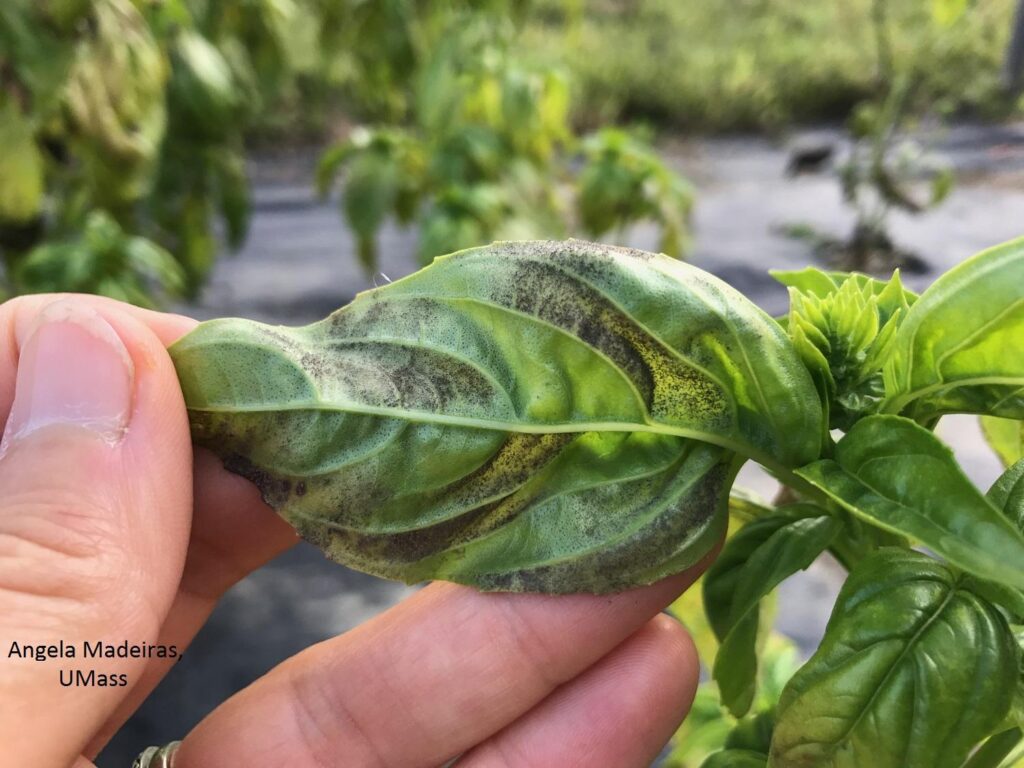
Recognizing Symptoms of Leaf Problems
Leaf problems in basil often reveal themselves through subtle yet telling signs. For example, angular black spots with fuzzy undersides typically signal downy mildew, a fungal disease exacerbated by stagnant air. Unlike bacterial infections, these spots align with leaf veins, a detail often overlooked by novice growers. This distinction is critical because fungicides effective against downy mildew won’t address bacterial pathogens like Pseudomonas cichorii.
Magnesium deficiency, for instance, causes interveinal chlorosis that progresses to necrotic patches, often mistaken for fungal damage. A 2024 study found that supplementing with magnesium sulfate reduced such symptoms by 60% in controlled trials.
To decode these issues, think of basil leaves as “living diagnostic tools.” Regularly inspect for patterns—symmetry, texture, and progression. Pair this with environmental adjustments, like improving airflow or tweaking nutrient ratios, to not only treat but preempt future problems.
Distinguishing Between Disease and Environmental Damage
One critical yet underappreciated distinction lies in the distribution of black spots. Disease-related damage, such as bacterial leaf spot, often follows predictable patterns—spots may cluster near water-splashed areas due to bacterial spread. In contrast, environmental damage, like cold stress, manifests as irregular blackening along leaf edges, where cells are most exposed to drafts or temperature drops.
A practical diagnostic tool is the “progression test.” Diseased leaves typically worsen over time, with spots enlarging or spreading to stems. Environmental damage, however, remains static once the stressor is removed. For instance, relocating a basil plant away from a draft halts further edge discoloration, confirming environmental stress as the culprit.
Misdiagnosing environmental damage as disease can lead to unnecessary fungicide use, which may harm beneficial microbes. Instead, focus on root cause analysis—adjust airflow, light, or temperature—to create a resilient growing environment.
Common Causes of Black Spots on Basil Leaves
Black spots on basil leaves often stem from a perfect storm of environmental and biological factors. Fungal infections, like Cercospora leaf spot, thrive in damp conditions, where overwatering or poor air circulation creates a breeding ground. Droplets on leaves act like magnifying glasses, intensifying light and weakening tissue, making it vulnerable to pathogens.
Insects, such as aphids, add another layer of complexity. Their feeding not only leaves behind black fecal spots but also introduces sticky honeydew, which invites sooty mold. This cascading effect can turn a minor pest issue into a full-blown fungal outbreak.
Nutrient deficiencies—often overlooked—can mimic disease. For example, potassium shortages weaken cell walls, making leaves more susceptible to damage. Misdiagnosing this as a fungal issue can lead to unnecessary treatments, compounding stress on the plant.
Combine visual cues with environmental adjustments to pinpoint the root cause effectively.
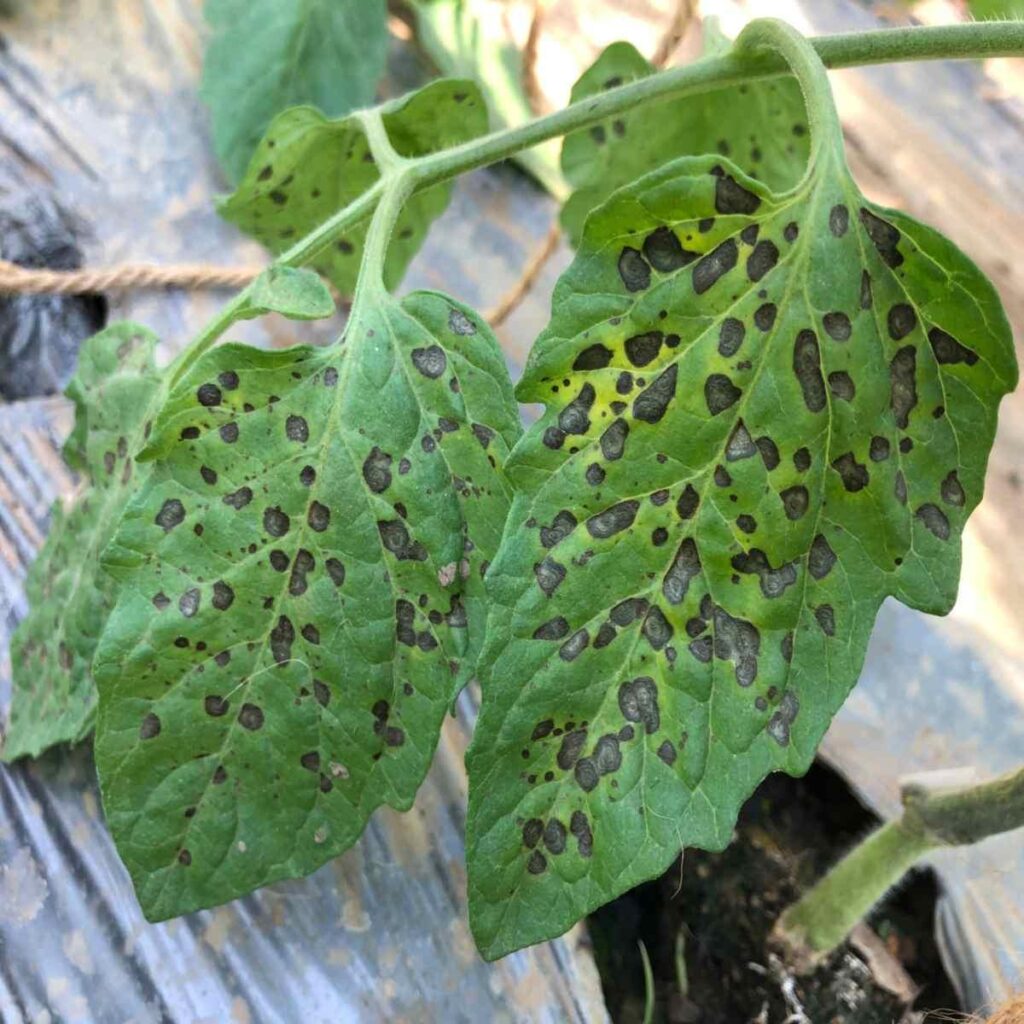
Fungal Infections: Downy Mildew and Leaf Spot
Downy mildew and leaf spot infections exploit one critical weakness: microclimate imbalance. High humidity, often above 70%, creates a haven for pathogens like Peronospora belbahrii. These fungi thrive in stagnant air, where moisture lingers on leaf surfaces, enabling spore germination. Think of it as a slow-motion invasion—spores settle, germinate, and spread, often unnoticed until damage is severe.
Installing a small fan near your basil plants can disrupt this humid microclimate, reducing fungal viability. Pair this with pruning lower leaves to improve air circulation and light penetration.
Over-fertilized soil, rich in nitrogen, promotes lush, dense foliage—perfect for trapping moisture. Opt for balanced fertilizers to avoid this unintended consequence.
Managing fungal infections isn’t just about treatment; it’s about reshaping the plant’s environment to make it inhospitable for pathogens.
Bacterial Diseases Affecting Basil Leaves
Bacterial pathogens like Xanthomonas campestris thrive in environments where wet leaves and poor drainage intersect. These bacteria infiltrate through natural openings or wounds, creating lesions with yellow halos—a hallmark of bacterial leaf spot. Watering at the base, rather than overhead, minimizes leaf wetness, disrupting bacterial proliferation.
Copper-based bactericides are effective but often overused. Excessive application can harm beneficial microbes, reducing soil biodiversity. Instead, integrating natural remedies like neem oil offers a gentler, sustainable alternative. Neem disrupts bacterial cell membranes without collateral damage to the ecosystem.
Overcrowding traps humidity, accelerating bacterial spread. Spacing plants appropriately not only reduces disease risk but also enhances airflow and light exposure, promoting overall vigor.
Effective bacterial management isn’t just reactive; it’s a holistic strategy that balances prevention, treatment, and environmental stewardship.
Insect Pests and Their Impact on Foliage
Aphids, thrips, and spider mites are more than nuisances—they’re vectors for secondary infections. These pests pierce basil leaves to extract sap, leaving behind tiny black spots and a sticky residue called honeydew. This residue fosters sooty mold growth, compounding damage and reducing photosynthetic efficiency. The solution? Integrated Pest Management (IPM).
IPM combines biological controls, like introducing predatory insects (e.g., ladybugs), with mechanical methods such as washing leaves with soapy water. This dual approach minimizes chemical reliance, preserving beneficial organisms while targeting pests effectively. For indoor growers, sticky traps can monitor infestations without disrupting the plant’s ecosystem.
Over-fertilization can attract pests by increasing nitrogen levels, which makes sap more appealing. Balancing nutrient inputs not only deters pests but also strengthens basil’s natural defenses.
Pest control isn’t isolated—it’s a dynamic interplay of nutrition, environment, and proactive monitoring.
Environmental Stress and Nutrient Deficiencies
Temperature fluctuations are an underestimated driver of black spots on basil leaves. When temperatures drop below 50°F, basil experiences cellular damage, particularly in young leaves, leading to blackened edges. Conversely, excessive heat can dehydrate the plant, causing stress that mimics nutrient deficiencies.
Using grow tents or thermal covers indoors stabilizes temperature swings, creating a consistent environment. Pair this with humidity regulation—keeping levels between 60–70%—to prevent stress-induced fungal susceptibility. For outdoor growers, planting basil after the last frost and using mulch to insulate roots can mitigate cold stress.
Soil pH. Basil thrives in slightly acidic to neutral soil (pH 6.0–7.0). Imbalanced pH can lock out nutrients like magnesium and potassium, exacerbating deficiencies. Regular soil testing and amendments, such as lime or sulfur, ensure optimal nutrient uptake.
Environmental stress and nutrient health are inseparable—addressing one strengthens the other.
Diagnosing Basil Leaf Problems
Diagnosing basil leaf problems is like solving a puzzle—each symptom is a clue. For instance, black spots near the leaf edges often signal fungal infections like downy mildew, especially in high-humidity environments. But if the spots are irregular and accompanied by sticky residue, pests like aphids or whiteflies may be the culprits. The distinction? Fungal issues spread rapidly under stagnant air, while pest damage is localized and often visible on the underside of leaves.
While true in some cases, magnesium deficiency can cause interveinal yellowing, particularly in older leaves. Dissolve one tablespoon of Epsom salts in a gallon of water and apply monthly to fix it.
Expert growers emphasize the importance of pattern recognition. For example, bacterial leaf spot creates water-soaked lesions, unlike the dry, brittle damage caused by nutrient imbalances. By combining visual cues with environmental data, you can pinpoint and address issues effectively.
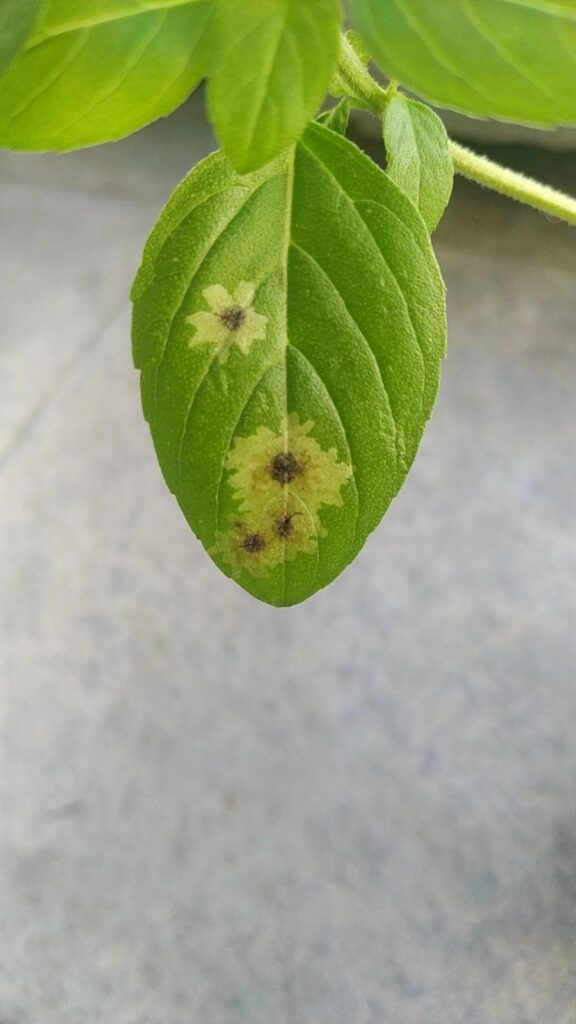
Step-by-Step Diagnostic Process
Start with the basics: observe the distribution of symptoms. Are the spots clustered on older leaves? This often points to nutrient deficiencies, as mobile nutrients like nitrogen are redirected to new growth. Conversely, random spotting across all leaves may indicate environmental stress or pathogens.
Next, test the microclimate. Use a hygrometer to measure humidity levels near the plant. High readings (above 70%) combined with poor airflow create a breeding ground for fungal diseases like downy mildew. A simple fix? Position a small fan nearby to improve circulation.
Finally, examine the leaf texture. Soft, water-soaked lesions suggest bacterial infections, while dry, brittle patches often stem from overexposure to light. Here’s a pro tip: use a magnifying glass to check for pest activity, such as webbing from spider mites.
By layering these observations, you can isolate the root cause with precision. This method not only saves time but also prevents unnecessary treatments that could harm your basil.
Utilizing Diagnostic Tools and Resources
Leverage digital imaging tools to analyze leaf discoloration patterns. Smartphone apps equipped with machine learning algorithms can identify diseases like downy mildew or bacterial leaf spot with over 90% accuracy. These tools work by comparing uploaded images to extensive plant disease databases, offering instant, actionable insights.
For a deeper dive, consider chlorophyll meters. These devices measure chlorophyll content, helping to distinguish between nutrient deficiencies and disease. For instance, low chlorophyll levels paired with yellowing leaves often indicate nitrogen deficiency, while uneven discoloration suggests fungal infections.
Don’t overlook soil testing kits. Imbalanced pH or nutrient levels can exacerbate leaf issues, yet this factor is frequently ignored. A pH below 6.0, for example, limits calcium uptake, weakening leaf cuticles and increasing susceptibility to pathogens.
By integrating these tools into your routine, you not only enhance diagnostic precision but also reduce reliance on trial-and-error methods, saving both time and resources.
Consulting Expert Advice
Engaging with horticultural experts can uncover nuanced solutions to persistent basil leaf issues. For example, specialists often recommend analyzing microclimate factors—a detail overlooked by many home gardeners. Experts can identify subtle imbalances, such as localized humidity pockets, which foster fungal growth despite overall adequate ventilation.
Online forums and professional networks, like those hosted by agricultural universities, provide access to peer-reviewed insights. These platforms often highlight unconventional remedies, such as using silicon-based foliar sprays to strengthen leaf cuticles against pathogens. This approach, though less mainstream, has shown promising results in controlled studies.
Additionally, consulting experts can bridge gaps between disciplines. For instance, integrating entomology knowledge helps identify pest-related stress that mimics disease symptoms. By combining expertise across fields, you can implement targeted interventions rather than broad-spectrum treatments.
Ultimately, expert advice transforms reactive care into proactive strategies, ensuring healthier plants and more efficient resource use.
Effective Treatment Solutions
Treating black spots on basil requires a blend of precision and adaptability. Start by removing infected leaves with sterilized tools—this prevents the spread of pathogens. Think of it as pruning a diseased branch to save the tree. For fungal infections, neem oil and copper-based fungicides are effective, creating a protective barrier while maintaining organic integrity. Studies show neem oil reduces fungal spore viability by up to 80%, making it a go-to for eco-conscious gardeners.
For bacterial issues, improving airflow and reducing leaf wetness are critical. Experts recommend spacing plants at least 6 inches apart to minimize humidity pockets. Surprisingly, even something as simple as watering at the base rather than overhead can drastically reduce bacterial spread.
By raising leaf surface pH, Baking soda sprays create an inhospitable environment for fungi. Combine these methods with consistent monitoring, and you’ll transform reactive care into a sustainable, proactive strategy.
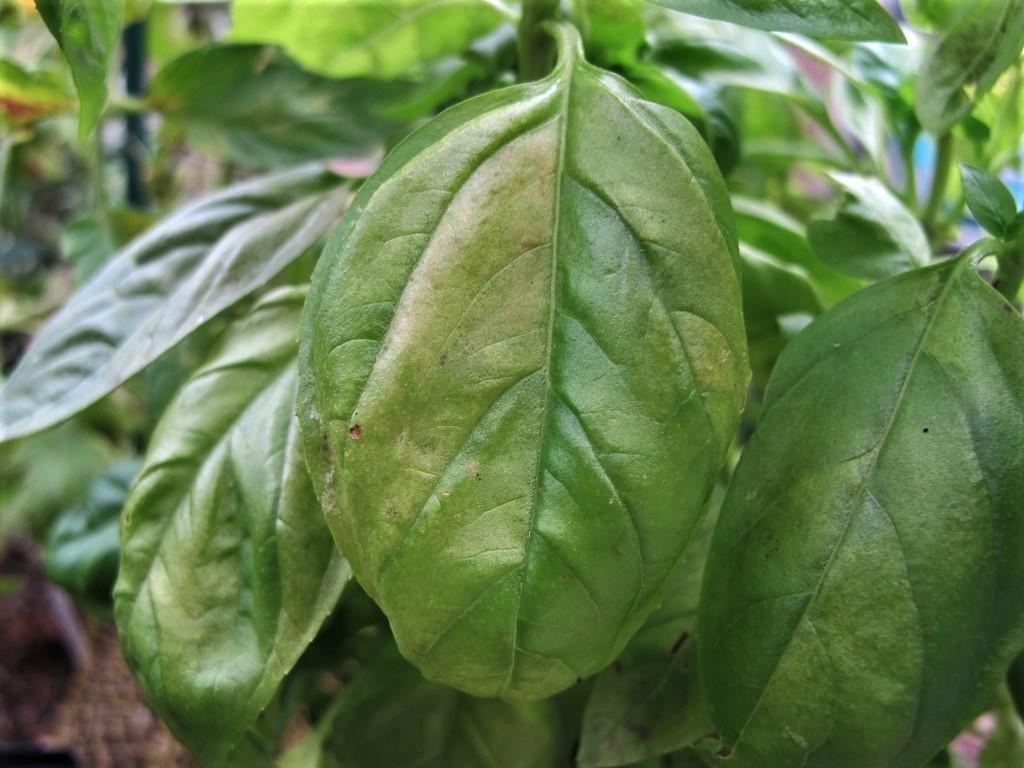
Organic Remedies and Natural Treatments
Neem oil isn’t just a natural fungicide—it’s a multitasking powerhouse. Its active compound, azadirachtin, disrupts fungal growth while deterring pests like aphids. Research highlights its dual-action benefits: a 2019 study found neem oil reduced fungal infections by 70% while preserving beneficial insects. To apply, dilute it with water (1 teaspoon per quart) and spray during early morning hours to avoid leaf burn.
Packed with sulfur compounds, garlic acts as a natural antifungal and antibacterial agent. It’s particularly effective against early-stage infections, creating a protective shield on leaf surfaces. Blend crushed garlic with water, strain, and apply weekly for best results.
For a science-backed twist, consider baking soda. By altering leaf pH, it halts fungal spore germination. Combine 1 teaspoon of baking soda with a drop of dish soap in a quart of water. These remedies, when rotated, prevent resistance and ensure long-term plant health.
Chemical Control Methods
Copper-based fungicides, such as copper hydroxide, are a cornerstone of chemical control for basil black spots. They work by creating a protective barrier on leaf surfaces, preventing fungal spores from germinating. However, their effectiveness hinges on precise application—too much copper can accumulate in the soil, disrupting microbial balance. To mitigate this, apply sparingly (every 7–10 days) and only during early morning or late evening to minimize harm to pollinators.
For severe infections, systemic fungicides like thiophanate-methyl offer a targeted approach. Unlike contact fungicides, these penetrate plant tissues, eradicating pathogens from within. This makes them ideal for infections that have spread beyond visible symptoms. Yet, overuse can lead to resistance, a growing concern in agricultural disciplines.
Integrating these methods with environmental adjustments—like improved airflow—enhances outcomes. By combining chemical precision with ecological awareness, growers can achieve sustainable disease management without compromising plant or soil health.
Managing Pests with Integrated Pest Management
Biological controls, a key pillar of Integrated Pest Management (IPM), leverage natural predators like parasitic wasps and ladybugs to suppress pest populations. These organisms target specific pests—such as aphids and spider mites—without harming beneficial insects or the basil plant itself. For instance, releasing Phytoseiulus persimilis mites in controlled environments has proven effective against spider mite infestations, reducing the need for chemical interventions.
Companion planting with herbs like dill or marigold can repel pests while enhancing biodiversity. This approach not only deters harmful insects but also fosters a resilient micro-ecosystem, reducing the likelihood of future outbreaks.
Recent studies suggest that pest-resistant basil cultivars, bred for stronger cuticles and higher essential oil content, can naturally deter pests. By combining these strategies, growers can create a dynamic, self-regulating system that minimizes pest damage while promoting sustainable cultivation practices.
Adjusting Care Practices to Mitigate Issues
Instead of overhead watering, which splashes soil onto leaves and fosters fungal growth, focus on base watering. This method keeps foliage dry while ensuring roots receive consistent moisture. For example, using a self-watering pot can maintain optimal soil hydration without risking waterlogging—a common culprit behind black spots.
Basil thrives between 70–85°F, but sudden fluctuations can stress the plant, weakening its defenses. Placing basil away from drafty windows or heat vents stabilizes its microclimate, reducing susceptibility to diseases like downy mildew.
Studies show that full-spectrum LED lights not only boost photosynthesis but also enhance cuticle thickness, creating a natural barrier against pathogens. By integrating these adjustments, growers can create a tailored care framework that mitigates issues while optimizing basil’s growth potential.
Preventing Future Leaf Issues
Prevention starts with understanding basil’s natural ecosystem. Think of your plant as a guest from the Mediterranean—thriving in well-drained soil, abundant sunlight, and dry air. Mimicking these conditions indoors means spacing plants 6–12 inches apart for airflow and using a fan to reduce humidity, which discourages fungal growth. A case study from urban gardeners in humid climates found that consistent airflow reduced downy mildew by 40%.
Regularly testing pH (ideal: 6.0–7.0) and incorporating compost ensures balanced nutrients. Over-fertilizing, however, can backfire, promoting weak, disease-prone growth. Experts recommend a slow-release organic fertilizer to maintain steady nutrient availability.
Beyond photosynthesis, full-spectrum LEDs strengthen leaf cuticles, acting like a plant’s armor. This connection between light quality and disease resistance is often overlooked but critical. By combining these strategies, you create a resilient environment where basil thrives, not just survives.
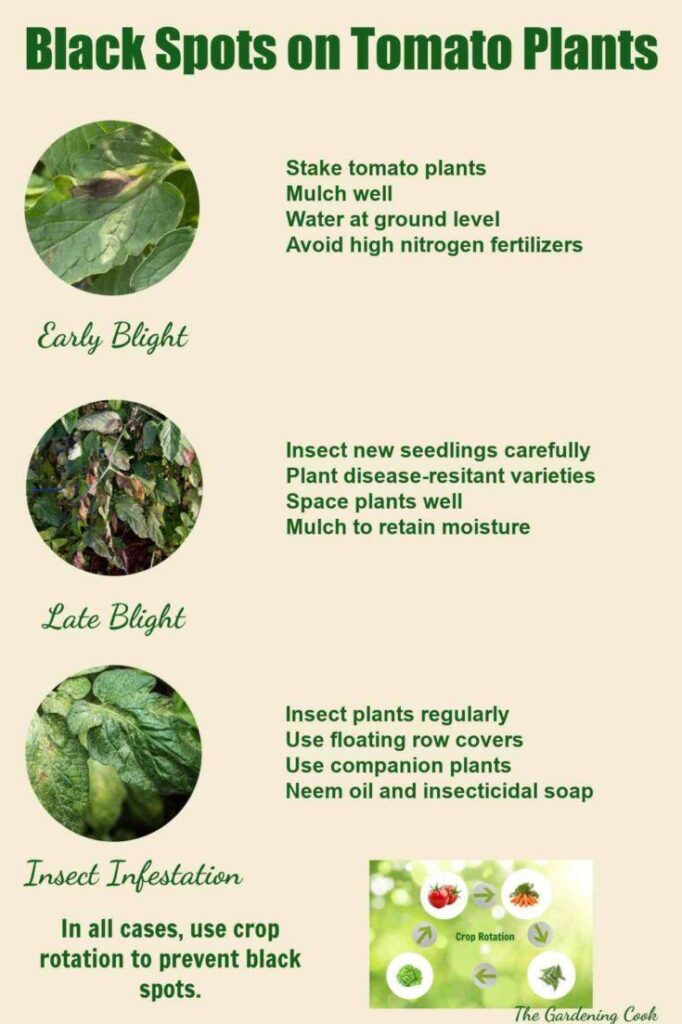
Best Practices for Indoor Basil Care
Focus on watering precision—a deceptively simple yet critical factor. Overwatering is the silent killer of indoor basil, often mistaken for nutrient deficiencies or disease. Research shows that basil roots thrive in soil with consistent moisture, but not saturation. Use a moisture meter to maintain a reading of 4–5, and water only when the top inch of soil feels dry. This approach prevents root rot while supporting steady growth.
Basil’s sweet spot is 70°F–80°F (21°C–27°C). Sudden drops, like those near drafty windows, can stress the plant, making it vulnerable to pests. Insulate pots with bubble wrap during colder months—a trick borrowed from greenhouse growers.
Mimic natural daylight by setting grow lights to 12–14 hours daily. Studies reveal this rhythm optimizes photosynthesis and essential oil production, enhancing both plant health and flavor.
Implementing Preventative Measures
Poor airflow creates microclimates of high humidity around basil leaves, fostering pathogen growth. Position a small oscillating fan near your plants to maintain consistent air movement. This not only reduces humidity pockets but also strengthens stems through mechanical stimulation, a concept borrowed from agricultural wind stress studies.
Pathogens often hitch a ride on pruning shears or reused pots. Use a 10% bleach solution or rubbing alcohol to disinfect equipment before and after use. This simple step can drastically reduce cross-contamination risks, especially in shared indoor gardening spaces.
Finally, consider companion planting. Basil thrives alongside pest-repellent plants like marigolds, which deter aphids and whiteflies. This synergy minimizes pest pressure while promoting biodiversity—a principle rooted in permaculture. Together, these measures create a resilient, self-sustaining indoor ecosystem.
Monitoring Plant Health Over Time
Focus on leaf texture analysis—a subtle yet powerful indicator of basil health. Healthy leaves should feel supple and slightly waxy, a sign of a robust cuticle layer that protects against pathogens. If leaves become brittle or overly soft, it may signal nutrient imbalances or environmental stress. Regular tactile inspections, combined with visual cues, provide a low-tech yet effective diagnostic tool.
Integrating digital tools like chlorophyll meters can elevate monitoring precision. These devices measure chlorophyll content, offering real-time insights into nutrient uptake and photosynthetic efficiency. For example, a sudden drop in chlorophyll levels might indicate nitrogen deficiency, allowing for timely intervention.
Lastly, adopt a data-driven approach. Maintain a log of environmental conditions, watering schedules, and observed symptoms. Over time, patterns will emerge, helping you predict and prevent issues before they escalate. This method mirrors predictive analytics in agriculture, proving that even small-scale gardeners can benefit from systematic tracking.
Advanced Techniques for Healthy Indoor Basil
Research shows that red and blue wavelengths not only enhance photosynthesis but also boost essential oil production in basil, improving both growth and flavor. For instance, full-spectrum LED grow lights with adjustable settings allow you to fine-tune light exposure, mimicking natural sunlight while reducing energy costs.
Studies highlight that maintaining a pH range of 5.5–6.8 and electrical conductivity (EC) levels between 1.0 and 1.6 ensures optimal nutrient absorption. A case study on hydroponic basil revealed that consistent EC monitoring led to a 20% increase in yield compared to traditional soil methods.
While unconventional, pairing basil with pest-repellent plants like marigolds can naturally deter aphids and whiteflies. This technique mirrors ecological balance in outdoor gardens, proving that even small indoor setups can benefit from biodiversity.
Optimizing Growing Conditions with Technology
Smart systems are revolutionizing basil cultivation by dynamically adjusting environmental parameters. For example, sensor-driven LED lighting systems can modify light intensity and spectrum in real-time, ensuring plants receive optimal wavelengths for each growth stage. A 2020 study found that basil grown under adaptive LED systems achieved a 15% higher yield compared to static lighting setups, highlighting the efficiency of this approach.
Beyond lighting, automated climate control systems integrate temperature, humidity, and airflow management. These systems use predictive algorithms to maintain ideal conditions, reducing the risk of fungal diseases like downy mildew. This is particularly impactful in vertical farms, where high plant density can exacerbate microclimate imbalances.
Integrating Internet of Things (IoT) devices allows growers to monitor and adjust conditions remotely. This not only saves time but also minimizes human error. By combining these technologies, indoor gardeners can create a self-regulating ecosystem that maximizes both yield and plant health.
Hydroponic and Aeroponic Basil Cultivation
In hydroponics, nutrient solutions are continuously circulated, ensuring consistent access to essential minerals. However, aeroponics takes this a step further by delivering nutrients as a fine mist directly to the roots, enhancing oxygen availability. Studies show that aeroponic systems can boost basil growth rates by up to 20% compared to traditional hydroponics, due to improved root respiration.
By misting rather than submerging roots, water consumption can be reduced by up to 90%, making it ideal for urban settings with limited resources. This aligns with sustainable practices, reducing both water waste and nutrient runoff.
Interestingly, combining aeroponics with microbial inoculants can further enhance nutrient uptake. Beneficial microbes colonize root surfaces, improving absorption and resilience against pathogens. This synergy offers a forward-looking framework for maximizing basil yield and quality.
Breeding and Selecting Disease-Resistant Varieties
A pivotal focus in breeding disease-resistant basil varieties is the integration of genetic resistance to fungal pathogens. For instance, cultivars resistant to downy mildew (Peronospora belbahrii) have been developed by identifying and incorporating specific resistance genes. These genes enable plants to produce proteins that disrupt the pathogen’s lifecycle, significantly reducing infection rates. Real-world applications, such as the introduction of mildew-resistant basil in commercial greenhouses, have demonstrated up to a 40% reduction in crop loss.
Marker-assisted selection (MAS) uses genetic markers linked to disease resistance traits, accelerating the breeding process. Unlike traditional methods, MAS allows breeders to screen seedlings for resistance before planting, saving time and resources.
Studies suggest that blue light enhances the activation of defense-related genes, offering a complementary strategy. Combining genetic resistance with optimized environmental conditions creates a robust framework for disease management.
FAQ About Solving Indoor Basil Growing Problems
What causes black spots on indoor basil leaves?
Black spots are caused by fungal infections (Alternaria, Pythium), bacterial diseases (Xanthomonas, Pseudomonas), environmental stress (cold drafts, excess moisture, poor light), or improper watering. Identifying the cause helps in effective treatment.
How to differentiate fungal, bacterial, and environmental damage?
- Fungal infections: Dark, circular spots with fuzzy or powdery growth, spreading in humidity.
- Bacterial damage: Water-soaked, greasy lesions with yellow halos, often leading to leaf drop.
- Environmental stress: Even browning at leaf edges from cold, nutrient deficiencies, or inconsistent care.
How to prevent black spots on basil?
Provide 6–8 hours of sunlight or use full-spectrum LEDs.Improve air circulation with spacing and a fan.Water at the base to prevent fungal spread.Use well-draining soil (pH 6.0–7.0) with compost.Prune infected leaves and sterilize tools to prevent disease.
What are effective organic and chemical treatments?
- Organic: Neem oil (fungicide), garlic spray (natural barrier), baking soda mix (pH control).
- Chemical: Copper fungicides prevent fungal spread; Mancozeb and Thiophanate-Methyl work for severe cases.
Apply early morning/evening to protect beneficial insects.
How do light, humidity, and nutrients affect basil health?
- Light: 6–8 hours of sunlight/full-spectrum LEDs for strong growth.
- Humidity: 60–70% to prevent dryness but avoid excess moisture. Use fans for airflow.
- Nutrients: Balanced nitrogen (leaf growth), phosphorus (roots), and potassium (disease resistance). Magnesium (Epsom salt) prevents yellowing.
By optimizing these conditions, your basil stays healthy and resilient.
Conclusion
Growing basil indoors is as much an art as it is a science. While black spots and leaf issues may seem like minor setbacks, they often signal deeper imbalances in the plant’s environment. Think of your basil as a living barometer—its health reflects the harmony (or lack thereof) in light, humidity, and nutrients. For instance, a study on indoor herbs found that plants receiving 6–8 hours of full-spectrum light daily produced 30% more essential oils, directly enhancing their flavor and resilience.
A common misconception is that more water equals healthier plants. In reality, overwatering creates a breeding ground for fungal infections. Instead, precise watering—like a chef seasoning a dish—yields better results. Experts also emphasize the role of airflow; even a small desk fan can reduce humidity and prevent disease.
Ultimately, solving these issues isn’t just about fixing symptoms. It’s about creating a thriving micro-ecosystem where your basil can flourish.
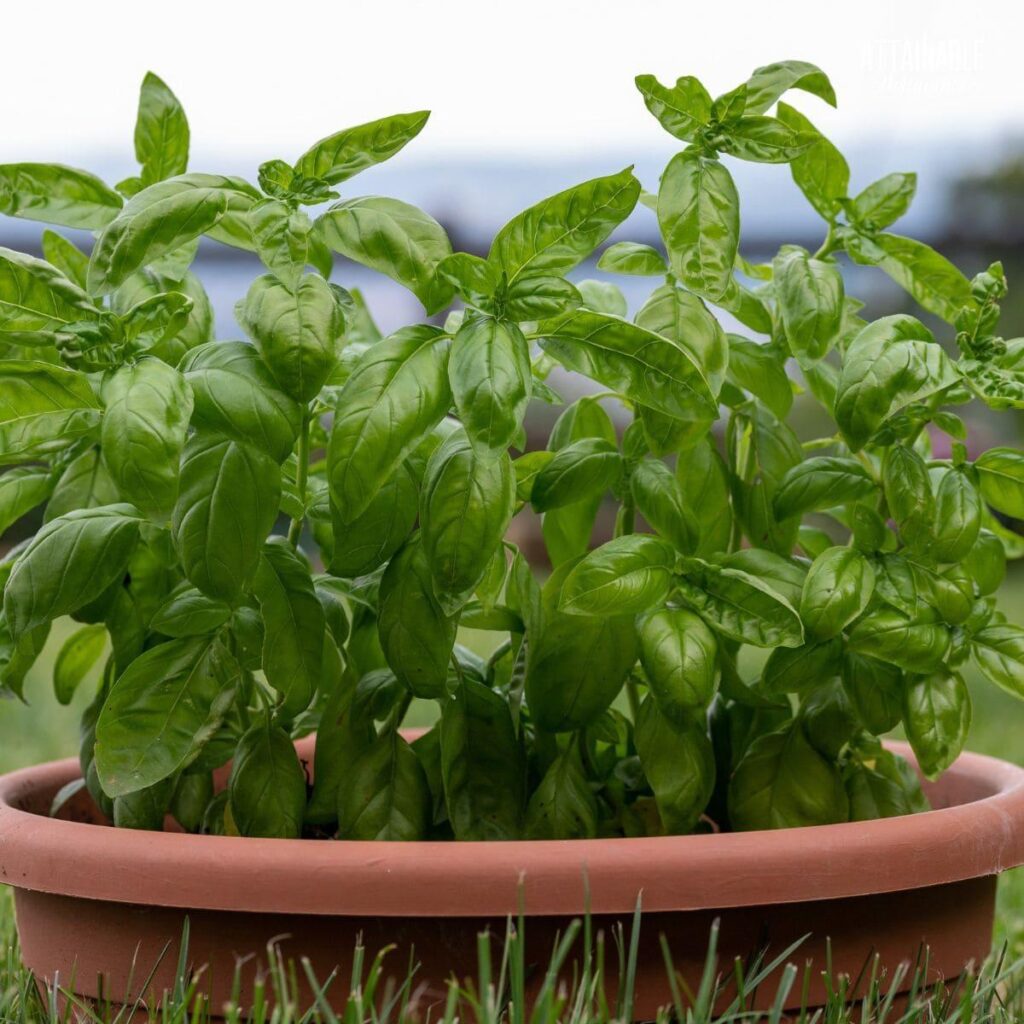
Looking Ahead: The Future of Indoor Basil Growing
The future of indoor basil cultivation lies in adaptive lighting systems. Emerging technologies like tunable LED lights allow growers to adjust light spectra dynamically, optimizing photosynthesis and essential oil production. For instance, increasing red wavelengths during flowering stages can enhance flavor profiles, while blue light boosts leaf density. This precision not only improves yield but also reduces energy consumption, aligning with sustainable practices.
Another promising frontier is AI-driven environmental monitoring. By integrating IoT sensors with machine learning algorithms, growers can receive real-time insights into humidity, temperature, and nutrient levels. These systems predict potential stressors, enabling preemptive adjustments that minimize disease risks and maximize plant health.
Finally, closed-loop hydroponic systems are gaining traction. These setups recycle water and nutrients, drastically reducing waste. When paired with microbial inoculants, they enhance nutrient uptake and root resilience. Together, these innovations pave the way for efficient, eco-friendly indoor gardening solutions.
Related posts
![]()
About Michelle Wilde
Michelle Wilde is a stay-at-home mom and avid plant lover. Armed with a post-graduate degree in Computer Science (no kidding!), she loves researching plants and landscapes. When she is not caring for her 4 kids, she spends time on her passion for plants. She blogs at www.indoorplantschannel.com, the trusted source for indoor plants.
Learn more
Subscribe
* You will receive the latest posts and updates about indoor plants!
Search
Recent Posts
Categories
- Beginner Guides (10)
- FAQ (206)
- General (2)
- How-To Guides (212)
- Indoor Plants (214)
- Pest Management (2)
- Plant Problem Solutions (4)
- Seasonal Growing (2)
- Specialized Environments (2)
- Specific Plant Care (3)
- Technical Growing (2)
